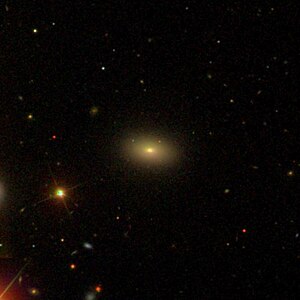NGC 1008
| Galaxy NGC 1008 |
|
|---|---|

|
|
| AladinLite | |
| Constellation | whale |
|
Position equinox : J2000.0 , epoch : J2000.0 |
|
| Right ascension | 02 h 37 m 55.3 s |
| declination | + 02 ° 04 ′ 47 ″ |
| Appearance | |
| Morphological type | E. |
| Brightness (visual) | 13.9 likes |
| Brightness (B-band) | 14.9 mag |
| Angular expansion | 0.8 ′ × 0.6 ′ |
| Position angle | 85 ° |
| Surface brightness | 13.2 mag / arcmin² |
| Physical data | |
| Redshift | 0.021995 ± 0.000077 |
| Radial velocity | 6594 ± 23 km / s |
|
Stroke distance v rad / H 0 |
(296 ± 21) · 10 6 ly (90.6 ± 6.3) Mpc |
| history | |
| discovery | Albert Marth |
| Discovery date | January 15, 1865 |
| Catalog names | |
| NGC 1008 • UGC 2114 • PGC 9970 • CGCG 388-070 • MCG + 00-07-060 • 2MASX J02375526 + 0204470 • GALEX ASC J023755.40 + 020448.3 • LDCE 179 NED011 | |
NGC 1008 is an elliptical galaxy of Hubble type E3 in the constellation Cetus south of the ecliptic . It is an estimated 296 million light-years from the Milky Way and about 70,000 light-years across.
In the same area of the sky are u. a. the galaxies NGC 1004 , NGC 1007 , NGC 1016 , NGC 1019 .
The object was discovered on January 15, 1865 by the astronomer Albert Marth .
Web links
Commons : NGC 1008 - collection of images, videos, and audio files
